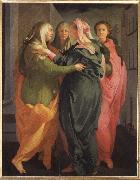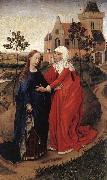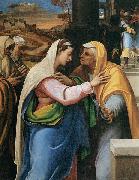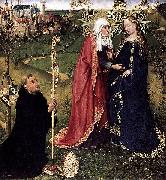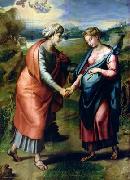
|
Pontormo, Jacopo
|
|||
|
|
|||
| b Pontormo, nr Empoli, 26 May 1494; d Florence, 31 Dec 1556). Italian painter and draughtsman. He was the leading painter in mid-16th-century Florence and one of the most original and extraordinary of Mannerist artists. His eccentric personality, solitary and slow working habits and capricious attitude towards his patrons are described by Vasari; his own diary, which covers the years 1554-6, further reveals a character with neurotic and secretive aspects. Pontormo enjoyed the protection of the Medici family throughout his career but, unlike Agnolo Bronzino and Giorgio Vasari, did not become court painter. His subjective portrait style did not lend itself to the state portrait. He produced few mythological works and after 1540 devoted himself almost exclusively to religious subjects. His drawings, mainly figure studies in red and black chalk, are among the highest expressions of the great Florentine tradition of draughtsmanship; close to 400 survive, forming arguably the most important body of drawings by a Mannerist painter. His highly personal style was much influenced by Michelangelo | |||
|
|
|||
|
Visitation new9/Pontormo, Jacopo-944334.jpg Painting ID:: 33242 |
mk83 c.1528-1529 | ||
|
|
|||
|
WEYDEN, Rogier van der
|
|||
|
|
|||
| Netherlandish Northern Renaissance Painter, ca.1400-1464 major early Flemish master, known also as Roger de la Pasture. He is believed to have studied with Robert Campin. His early works also show the influence of Jan van Eyck. Van Eyck, however, had been a master at objective rendering of detail, whereas Roger in his work portrayed emotions with an assurance that has not been surpassed. His ability to depict piety is reflected in the early masterpiece Descent from the Cross (c.1435; Prado); he depicted with significant restraint the profound grief of the mourners grouped around the tragic figure of Jesus. His composition strongly affected later representations of the theme. Roger became City Painter in Brussels in 1436. He then produced a series of undated altarpieces including the Last Judgment (hospital, Beaune), the Braque Triptych (Louvre), Crucifixion with Donors (Vienna), and Adoration of the Magi (Berlin), which vary in execution from a stress on sumptuous details to a more sculptural rendering of the figures. Roger is believed to have made a pilgrimage to Italy in the holy year 1450. Whether this supposed excursion had any effect on his style is much debated. It has been shown that his Entombment (Uffizi) bears an affinity to the Tuscan treatment of the subject, particularly by Fra Angelico, and that Roger's Virgin and Child with Saints (Frankfurt) has a strong resemblance to the Italian religious art of the day. His style is, however, highly individual. His religious paintings and his portraits are characterized by a straightforward monumentality. The portraits, such as that of a young lady (National Gall. of Art, Washington, D.C.) and of Francesco d'Este (Metropolitan Mus.) exhibit a simple clarity of contour and psychological penetration. Other notable works are his St. Luke Painting the Virgin, of which a version or replica is in the Museum of Fine Arts, Boston, the Crucifixion | |||
|
|
|||
|
Visitation new21/WEYDEN, Rogier van der-594294.jpg Painting ID:: 63876 |
1445 Oil on oak panel, 57 x 36 cm Museum der Bildenden K?nste, Leipzig This small Visitation, probably intended as a single panel, is related to the Miraflores Altarpiece, not in subject but in style. Comparatively speaking, it is a narrative picture, showing a definite event in its appropriate surroundings. Shortly after the Annunciation, Mary visits her cousin Elisabeth, who despite her advanced age has miraculously become pregnant, and has been carrying the future John the Baptist for six months. The picture illustrates the circumstances of the meeting described in St. Luke's Gospel much more clearly than many other earlier depictions. For example, the landscape divided up by paths behind the Virgin Mary, from which she seems to be approaching small figures of people riding and walking indicate that it is passable - show that she has traveled a long way to visit her cousin. Elisabeth lives in hilly country, represented by the hill with the complex of fortress-like buildings outside which her husband Zacharias is playing with a dog. The open courtyard gateway, and even more so the path dynamically winding downward, show that the pregnant older woman has hurried respectfully to meet the young girl as Mary takes the last few steps. Each of them acknowledges the miracle of pregnancy and is laying a hand on the other's belly, while Elisabeth's outstretched arm and pale hand, shown against Mary's dark blue dress, leave us in no doubt which is the more important child. The gestures, at once tender and eloquent, are typical of Rogier's expressive style. The picture is also closely related to the version of the same subject on the right wing of the Annunciation Triptych (Galleria Sabauda, Turin) which is of the same width but considerably taller and thus makes a much narrower composition. The smaller version therefore appears less dramatic by comparison; Elisabeth's house does not tower over her so much. It is possible that an older design by Rogier was the model for both painting. These hands and facial types, the figures, and such features as the modeling of the forms resemble those of the Miraflores Altarpiece. Dendrochronology provides a useful lead to the date of the Visitation, for the wooden panel used comes from the same piece of timber as a part of the panels of the picture known as the Abegg Triptych (Riggisberg near Berne), which was painted in Rogier's workshop and can be dated to around 1445.Artist:WEYDEN, Rogier van der Title: Visitation Painted in 1401-1450 , Flemish - - painting : religious | ||
|
|
|||
|
Sebastiano del Piombo
|
|||
|
|
|||
| 1485-1547 Italian Sebastiano del Piombo Galleries Italian painter. He was one of the most important artists in Italy in the first half of the 16th century, active in Venice and Rome. His early, Venetian, paintings are reminiscent of Giovanni Bellini and to a lesser extent of Giorgione. With his move to Rome in 1511 he came under the influence of Raphael and then of Michelangelo, who supplied him with drawings. After the death of Raphael (1520) he was the leading painter working in Rome and was particularly noted as a portrait painter. In his finest works, such as the Piete (1513; Viterbo, Mus. Civ.) and the Flagellation (1516-24; Rome, S Pietro in Montorio), there is a remarkable fusion of the Venetian use of colour and the grand manner of central Italian classicism. | |||
|
|
|||
|
Visitation new23/Sebastiano del Piombo-876735.jpg Painting ID:: 71420 |
Date 1518-1519 Medium Oil on canvas Dimensions 168 x 132 cm | ||
|
|
|||
|
DARET, Jacques
|
|||
|
|
|||
| Netherlandish Northern Renaissance Painter, ca.1404-1470 was an Early Netherlandish painter born in Tournai (now in Belgium), where he would spend much of his life. Daret spent 15 years as a pupil in the studio of Robert Campin, alongside Rogier or Rogelet de le Pasture (assumed by scholars to be Rogier van der Weyden, both words meaning "field" or "meadow" in French and Dutch respectively), and afterwards became a master in his own right. He became a favorite of the Burgundian court, and his patron for 20 years was the abbot of St. Vaast in Arras, Jean de Clercq. Though many works of Daret are mentioned in Jean de Clercq's account books, only four panels of Daret's works are known to have survived: all are from the so-called Arras Altarpiece or Saint-Vaast Altarpiece, painted for the abbot between 1433 and 1435. These paintings show a striking resemblance to the Flemish realism of the Master of Flemalle. This is argued by most scholars to be evidence that the Master of Flemalle was Daret's master, Robert Campin. Daret features rather more in the art historical debates over his period than the merit of his work alone would justify because he is relatively well-documented, and in particular can be securely identified as the creator of the altarpiece mentioned above, as well as a pupil of Campin. The stylistic similarity between him and the Master of Flemalle is therefore crucial evidence in the identification of the latter with Campin. This then becomes an important connection in establishing a link between Robert Campin/the Master of Flemalle and his other major pupil, | |||
|
|
|||
|
Visitation new25/DARET, Jacques-348883.jpg Painting ID:: 87013 |
between 1434(1434) and 1435(1435) Medium Oil on oak panel cyf | ||
|
|
|||
|
RAFFAELLO Sanzio
|
|||
|
|
|||
| Italian High Renaissance Painter, 1483-1520 Italian painter and architect. As a member of Perugino's workshop, he established his mastery by 17 and began receiving important commissions. In 1504 he moved to Florence, where he executed many of his famous Madonnas; his unity of composition and suppression of inessentials is evident in The Madonna of the Goldfinch (c. 1506). Though influenced by Leonardo da Vinci's chiaroscuro and sfumato, his figure types were his own creation, with round, gentle faces that reveal human sentiments raised to a sublime serenity. In 1508 he was summoned to Rome to decorate a suite of papal chambers in the Vatican. The frescoes in the Stanza della Segnatura are probably his greatest work; the most famous, The School of Athens (1510 C 11), is a complex and magnificently ordered allegory of secular knowledge showing Greek philosophers in an architectural setting. The Madonnas he painted in Rome show him turning away from his earlier work's serenity to emphasize movement and grandeur, partly under Michelangelo's High Renaissance influence. The Sistine Madonna (1513) shows the richness of colour and new boldness of compositional invention typical of his Roman period. He became the most important portraitist in Rome, designed 10 large tapestries to hang in the Sistine Chapel, designed a church and a chapel, assumed the direction of work on St. Peter's Basilica at the death of Donato Bramante, | |||
|
|
|||
|
Visitation new25/RAFFAELLO Sanzio-555753.jpg Painting ID:: 88268 |
1517(1517) Medium Oil on canvas Dimensions 200 x 145 cm (78.7 x 57.1 in) cjr | ||
|
|
|||
|
Also Buy::. For Following Paintings / Artists / Products, Please Use Our Search Online: |






